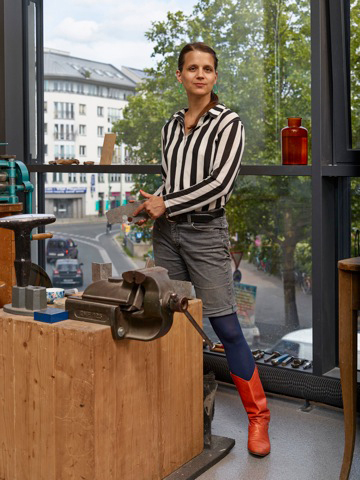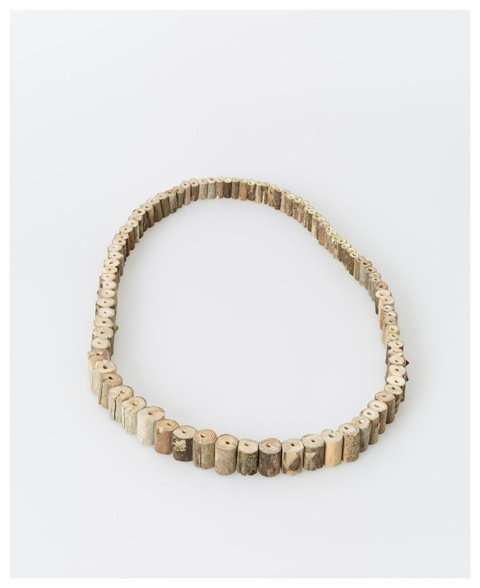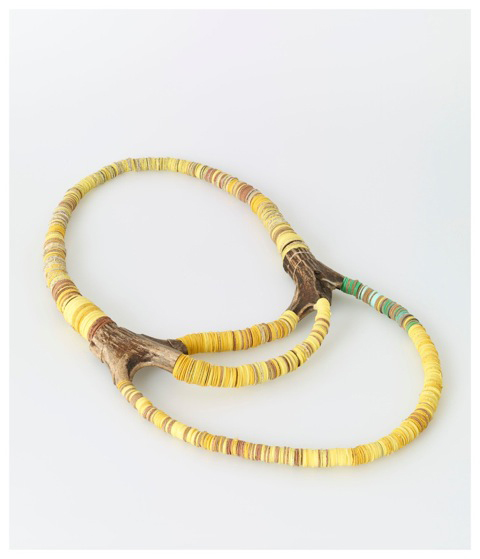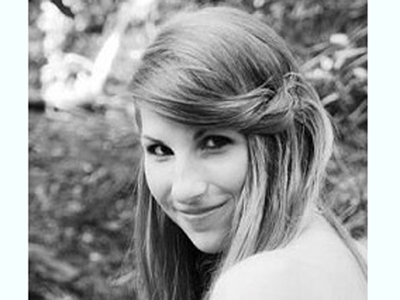
Missy Graff: How did you become interested in making jewelry? Please describe your background.
Silke Spitzer: Growing up as the daughter of an arts, music, and sports teacher, I cannot remember a time when I was not creating or making something. I was always sitting or kneeling barefoot on the ground, carving, drawing, sewing, painting, cutting, scribbling, collecting, adding, and combining the things that surrounded me. To me, creating and living have always seemed to be the same. The beauty of nature, light, smell, the deepness of a voice, a thought or special sound, have always touched me.
Growing up, I always considered creating a living by making with my own hands to be my dream job and life’s goal. Et voilà! I feel the same way today.
Why jewelry? Well, I guess it just happened. I grew up with the desire to create. Making jewelry was just one option I decided to explore. The tools seemed interesting and the scale seemed manageable. I enjoy the intimacy of making a piece all alone, by myself from the very beginning to the very end. I am very interested in the solitude that working on a small scale offers, a familiar scale, my body’s scale, a scale that is very much my soul’s size.

Missy Graff: How did you become interested in making jewelry? Please describe your background.
Silke Spitzer: Growing up as the daughter of an arts, music, and sports teacher, I cannot remember a time when I was not creating or making something. I was always sitting or kneeling barefoot on the ground, carving, drawing, sewing, painting, cutting, scribbling, collecting, adding, and combining the things that surrounded me. To me, creating and living have always seemed to be the same. The beauty of nature, light, smell, the deepness of a voice, a thought or special sound, have always touched me.
Growing up, I always considered creating a living by making with my own hands to be my dream job and life’s goal. Et voilà! I feel the same way today.
Why jewelry? Well, I guess it just happened. I grew up with the desire to create. Making jewelry was just one option I decided to explore. The tools seemed interesting and the scale seemed manageable. I enjoy the intimacy of making a piece all alone, by myself from the very beginning to the very end. I am very interested in the solitude that working on a small scale offers, a familiar scale, my body’s scale, a scale that is very much my soul’s size.

Silke Spitzer: My life and work are very much intertwined. The past few years have been incredibly challenging for me. The reality of death and loss hit me hard. Being able to make has helped me to gain ground and eventually see the beauty and richness in life and the things right next to me.
My life is getting more and more simple, so focusing on the essential, breathing, seems to be one of the most important but also most complicated things to do, since we often forget about it completely.
I do not think of a concept when I work. I love to let things flow and I follow. As I was working on the pieces for Breathing, I realized how much my life and work became one. During the most intense moments of the process—getting up really early in the morning to get things finished, collecting wood from the forest, as well as fallen slate from my neighbor’s roof, plastic, paper, and fabric that was around me—I couldn’t think anymore. Essentially, Breathing was all I could do.
Why did you choose the necklace as the primary format for the pieces in this exhibition?
Silke Spitzer: For the past few years the format of the necklace has just seemed right to me. It offers the possibility of thinking in a sculptural way and also the challenge of making a wearable, moveable, soft, and functional piece of jewelry.
The necklace, to me, is the most powerful and intimate piece of jewelry. It is right in front of the body and next to the heart, breathing with the body. I love the possibilities of scale and its sculptural qualities.

Silke Spitzer: The pieces in Breathing feel like they are the grown–up, and maybe more sophisticated, brothers and sisters of what I have done before. It feels like the silence has been broken. Life has become bigger and more powerful again, with vibrant colors and contrasts coming my way.
My previous work was made mainly from all natural wood pieces. For this series, I wanted to include a wider variety of materials. I wanted big contrasts between the silence and the noise that are in my life. I wanted to incorporate my natural side—the wood and the silent colors—but also the city life: plastics, strong contrasts, loud colors.
Do you consider how your work will interact with the breathing body while you are making it?
Silke Spitzer: While I am making a piece, Breathing evokes a feeling of calmness, small movement, and stability. It was the biggest compliment when someone said to me, “Those pieces look very quiet and yet alive.” Of course, the necklace format on its own evokes the idea of breathing, doesn’t it?
The process of making the pieces is very long. I cut many small pieces into smaller pieces again and again. It’s almost like a meditation or perhaps torture (depending on your preferences).
I build the pieces relative to my own body, and suitable to my personal scale. How they will work on the person who is wearing them, I can’t tell. How his or her breathing will be, I don’t know. But I hope for the best.

Silke Spitzer: To me, the idea of the body that comes with making jewelry, especially necklaces, is always present and very natural. The body is the pedestal, but even more than that, it is alive, always changing and moving. That is why it is such a big challenge to make necklaces. They are obvious and can be seen by anyone, but they are also very personal because they cover an intimate area of the body.
You are using several different materials in your work, such as aluminum, slate, plastic, fibers, and antler. How do you choose materials and how do they relate to your concepts?
Silke Spitzer: It is more about finding than choosing. For example, I started using twigs I found in my backyard because I was tired of ordering materials. This was when the very first wood twig necklaces happened. I enjoy the challenge of making something special out of something very simple, using materials and techniques that are available to everyone.
Most of the other materials I use come from my surroundings. I live on a small farm outside of Berlin in the former eastern part of Germany. The slate I use is from piles that have fallen off my neighbor’s roof. The wood is all around my house. I live right beside the forestry district of Berlin and that is where the antlers come from.
Most of the intense colors from the plastics, fabrics, and some of the other textiles are inspired by the city. My studio life is based in the middle of Kreuzberg, Berlin. Everyday I am exposed to the strong contrast between nature and the very modern city.

Silke Spitzer: They are all materials from the world I live in. They are very natural and yet very superficial. My work is a combination of the poetic, cultural, and formal rivers that float through my life.
I am a very down–to–earth person who loves to put her hands in the dirt and lie back to watch the clouds move, but I also love to put on high heels and see the city lights! Life in general is full of contrasts nowadays. We sit in front of the computer exploring the stars and the future. We also long for a simpler daily life, determined by the moment.
What is the most interesting exhibition you’ve seen lately?
Silke Spitzer: The last exhibition that really stroked my heart was a while ago. It was at the Documenta festival in Kassel in 2011, by a woman named Etel Adnan, who was born in 1925 in Beirut, Lebanon, and is a painter and a writer. Her small–scale paintings, both colorful and powerful, were hung in a long row in a big room containing at least 30 paintings. I admire her movement of colors. I admire how she offers her soul.
Something else that I think of as my companion is a small poetry book by Patti Smith. It is called Woolgathering. Go read it!




